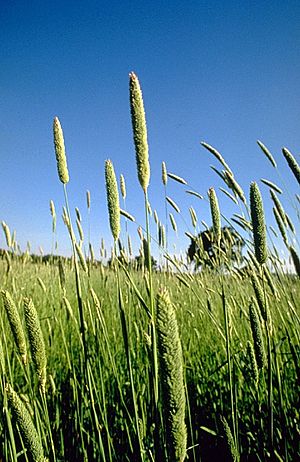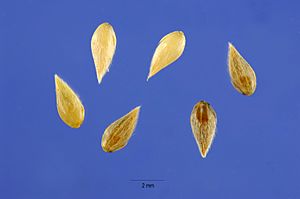Bulbous canary-grass facts for kids
Quick facts for kids Bulbous canary-grass |
|
|---|---|
 |
|
| Scientific classification | |
| Genus: |
Phalaris
|
| Species: |
aquatica
|
| Synonyms | |
|
Phalaris tuberosa |
|
Phalaris aquatica, also known as bulbous canary-grass or Harding grass, is a type of grass. It belongs to the Phalaris group within the Poaceae family, which is the grass family.
Contents
What it Looks Like
This grass grows upright and can reach about waist-high. It's a strong plant that lives for many years. It grows in clumps, which means it forms a dense group of stems. Its leaves are usually grayish or bluish-green.
The flowering parts of the plant are thick and look like spikes. They are usually 2 to 5 inches (50 to 125 mm) long. This grass grows slowly from its seeds. However, after a few years, it can form very large clumps.
Another type of grass, Phalaris arundinacea (reed canary grass), is a bit different. It has roots that spread out more, called rhizomes. Its flowers are tight at first but open up as the branches spread.
Scientists have even created new types of Harding grass by mixing it with reed canary grass. Some well-known types are 'AQ1', 'Uneta', and 'Australis'. P. aquatica grows quickly and uses the nitrogen in the soil very well.
Where it Grows
Phalaris aquatica first came from Southern Europe and the Caucasus mountains. Now, it grows naturally in many other places. These include South Africa, Australia, New Zealand, and the USA.
Even though it was brought to Australia recently, people there quickly saw how good it was for feeding animals. Because of this, farmers started growing it on purpose in the United States, Argentina, and other South American countries, as well as New Zealand.
Chemicals in the Plant
The leaves and young plants of Phalaris aquatica contain a chemical called gramine.
Used as Animal Food
Phalaris aquatica is a type of plant grown in pastures. It is eaten by animals that chew their cud, like cows and sheep. This grass can also be cut and stored. It provides good quality food for farm animals for most of the year, usually 8 to 12 months.
Plant Safety for Animals
Some types of Phalaris grass have chemicals that can cause health problems in sheep. These problems can affect their brain, other organs, or their nervous system. In serious cases, it can even lead to death. However, Phalaris aquatica is generally thought to be safe for sheep.
In Victoria, Australia, there have been reports of kangaroos eating Phalaris aquatica. Some of these kangaroos developed a condition called "Phalaris staggers." This condition affects their balance and how they move.
An Invasive Plant
Harding grass is considered an invasive species in some areas. This means it spreads quickly and can harm native plants and animals. It affects natural areas like grasslands, oak woodlands, chaparral (a type of shrubland), and riparian habitats (areas along rivers or streams). When Harding grass takes over, it can push out the plants that naturally grow there.
See also
 In Spanish: Alpiste para niños
In Spanish: Alpiste para niños


